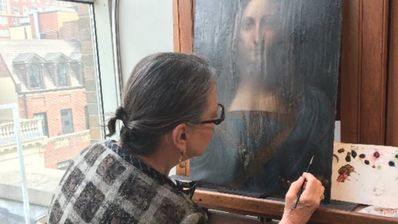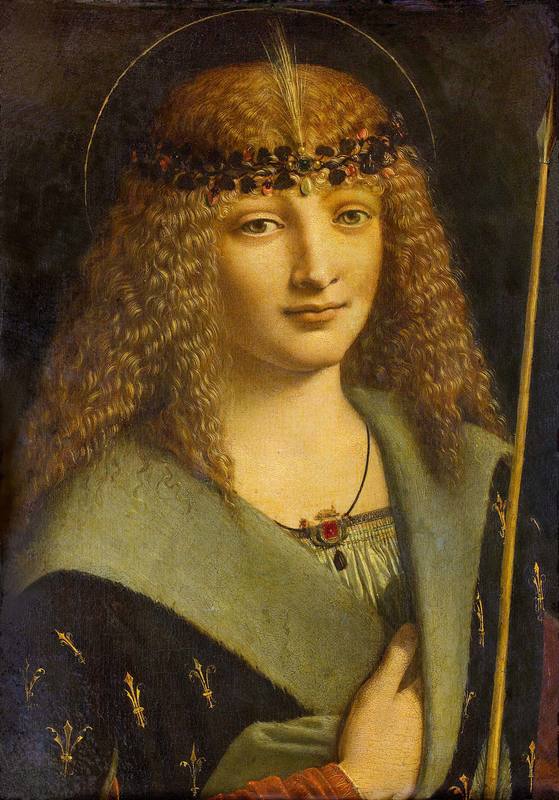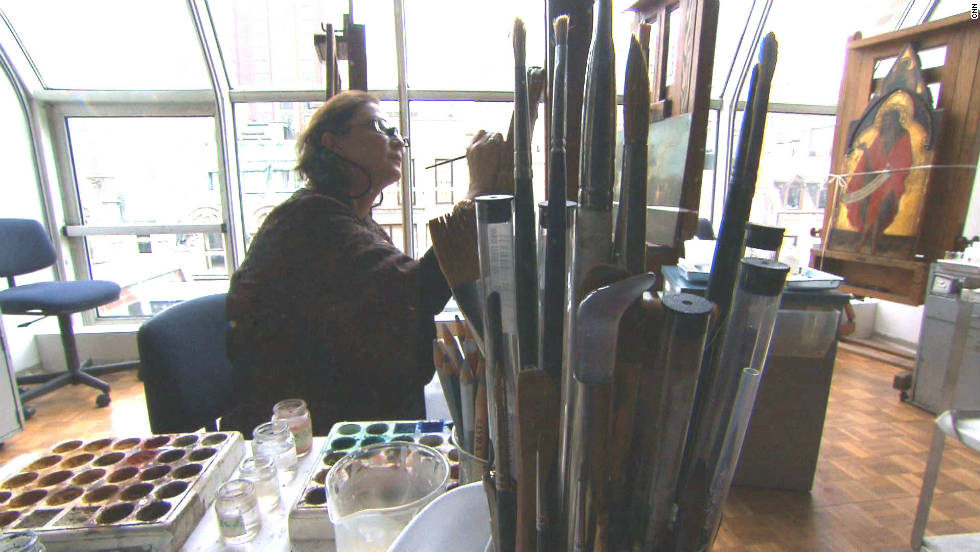|
Click on the photo above to see a high resolution image The whole world has heard of the "newly discovered" or "recently accredited" painting called Salvator Mundi (Savior of the World) becoming the highest price ever paid for a painting in history... $450 million. Wait. Let me put all those zeros back in for effect. That's $450,000,000. Nearly half a billion dollars! And of course, the main reason is that art experts claim the painting was created by the hand of Leonardo Da Vinci himself. But is this a fact, or merely the opinion of a bunch of art historians and experts hired by the 20 person American consortium that owned the painting? To add more drama to the transition from muddled, awkward, damaged painting to one touted with little doubt as one touched by the Master's Hand (and to trump up its predicted value at auction), Christie's auction house put together the following time-lapse video of the "transformation". (Yes, they actually tend to use the word "transformation", not "restoration"). Check out this video... Even though the consortium of Americans, led by Robert Simon of Robert Simon Fine Art (in the business of marketing Old Masters paintings), who raked in $450 million (less the 30% fee for Christie's) are very happy about the sale, many others still have doubts about the painting. At this point, no one is certain who bought it, but you can be sure we will see it again, marketed like crazy by some big name museum, with a full compliment of T-shirts, books, posters, pillows, mugs to bolster profits. Thomas Campbell, former director of the Metropolitan Museum of Art, was quoted recently that, while the sales price was “eye-popping, it should come as no surprise in a market where speculation, marketing and branding have displaced connoisseurship as the metrics of value” and that the price alone would "guarantee notoriety” even if their were ongoing doubts about its authenticity. He continued, “Someone is gambling that this painting will attract audiences in the way that the Mona Lisa draws crowds at the Louvre.” For the last several decades it seems that art "experts"--especially those associated or hired by fine art auction houses--hype and pump up prices as their main raison d'être. Even if the art is unworthy of attention, if they can draw attention to a work, its auction price will climb ever higher. Hucksters have invaded the fine art world, for sure. Many other experts aren't so sure this is in fact a painting by Da Vinci himself. In fact, until the last time it was sold at auction in 1958 for a mere £45, its authorship was unclear. It was previously attributed to the hand of Giovanni Antonio Boltraffio, a student in Da Vinci's studio and a Master in his own right. Compare the beauty and quality of his work below. Pay close attention to the hand, eyes, nose and curls of hair... Let's get into some of the "evidence" about why these experts think the Salvator Mundi is "the" Salvator Mundi by Da Vinci... Some claimed that the wood panel is similar to the panel in size and type that the Mona Lisa is painted on. They aren't.
Next, consider that Leonardo Da Vinci was left-handed. There is evidence in the Salvator Mundi that it was painted by a right-handed artist, as illustrated below... Then there is the orb that Jesus holds in his left hand. Most consider this to be a solid crystal orb rather than a hollow, blown glass sphere, as many other artists' versions of the Salvador Mundi illustrated. The artist painted bubbles trapped in the orb, as a solid quartz crystal would have. But many doubt that Da Vinci, who was as much a scientist as artist, would make a mistake about how the light would react when looking through such an orb. As anyone who studies optics knows, the orb would essentially become a lens, inverting the image seen through it, as Da Vinci himself illustrates in his notebooks... Here are side-by-side images. One of the Salvator Mundi as it shows the orb, and one that I retouched in Photoshop to show how DaVinci might have properly shown the optical effect of the orb. Not how even the drape in the garment is inverted... And as you can see from the un-retouched photo of a solid crystal orb above, the hand would not show through, as the Salvator Mundi showed Jesus' hand in the orb. Da Vinci would have known this.  Dianna Dwyer Modestini restoring the fragile wooden panel Dianna Dwyer Modestini restoring the fragile wooden panel I also find it curious, that there is no major film documenting the step by step restoration of the Salvator Mundi--at least, not that I can find. Typically a find of this magnitude would have an episode of PBS' NOVA documenting the science behind the discovery, analysis and restoration process. The person doing the restoration, Dianna Dwyer Modestini, is a fine artist in her own right, capable of restoration--or mimicking--the style of Da Vinci, or any other Old Master, for that matter. She worked for the Metropolitan Museum of Art until she and her husband went into the business of restoring paintings for major museums along with many private galleries. The question is, did her restoration go too far, or just far enough? The attribute the name of Da Vinci to such a work requires lots of science and trust. In this case, who do we trust? The consortium whose interest was motivated by the potential profits? The restoration expert who has been in the business of restoring paintings for private galleries to increase their appeal--and value? The museums who will surely put together huge exhibitions based on the Mundi and sell millions of dollars in ticket fees and gift shop products? Perhaps we'll never know for sure. For me at least, I won't be buying a T-shirt until I'm convinced... --Jerry Finzi While researching another subject using Google Earth, I came across this unusual scene just outside of Canosa di Puglia... a beautifully built Highway to Nowhere.
Oddly, the "street view" from several years ago shows nothing but dirt roads and farm fields. The satellite view taken in 2017 shows this beautifully built highway and a wonderfully wide roundabout in the middle. The only problem is, it goes nowhere and comes from no where. There are dirt roads and vineyards around all sides and the paved intersections intersect with dirt roads. There are no structures within the "development" area... just olives and grape vines. Go figure. Perhaps the regional government thought, "If we build it, they will come." --Jerry Finzi |
On AMAZON:
|














 RSS Feed
RSS Feed

